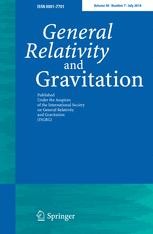GRG Editor's Choice: Quasi-local gravitational angular momentum and centre of mass from generalised Witten equations
 Wieland, W., Quasi-local gravitational angular momentum and centre of mass from generalised Witten equations, Gen Relativ Gravit (2017) 49: 38. doi:10.1007/s10714-017-2200-4
Wieland, W., Quasi-local gravitational angular momentum and centre of mass from generalised Witten equations, Gen Relativ Gravit (2017) 49: 38. doi:10.1007/s10714-017-2200-4
Editor's Choice (Research Article)
First Online: 10 February 2017
"This paper introduces a beautiful idea to treat a key technical question in general relativity, concerning asymptotic conserved charges and in particular angular momentum, notoriously plagued by ambiguities. While part of the main results had previously appeared, the author’s derivation is new, more solid and more general. The paper is well written and the comparison with the literature is clear and useful."
Abstract:
Witten’s proof for the positivity of the ADM mass gives a definition of energy in terms of three-surface spinors. In this paper, we give a generalisation for the remaining six Poincaré charges at spacelike infinity, which are the angular momentum and centre of mass. The construction improves on certain three-surface spinor equations introduced by Shaw. We solve these equations asymptotically obtaining the ten Poincaré charges as integrals over the Nester–Witten two-form. We point out that the defining differential equations can be extended to three-surfaces of arbitrary signature and we study them on the entire boundary of a compact four-dimensional region of spacetime. The resulting quasi-local expressions for energy and angular momentum are integrals over a two-dimensional cross-section of the boundary. For any two consecutive such cross-sections, conservation laws are derived that determine the influx (outflow) of matter and gravitational radiation.
The author:
Wolfgang Wieland currently is Postdoctoral Researcher at the Perimeter Institute in Waterloo, Canada. His research focus is on spinors in quantum gravity
GRG Editor's Choice:
In each volume of GRG, a few papers are marked as “Editor’s Choice”. The primary criteria is original, high quality research that is of wide interest within the community.
